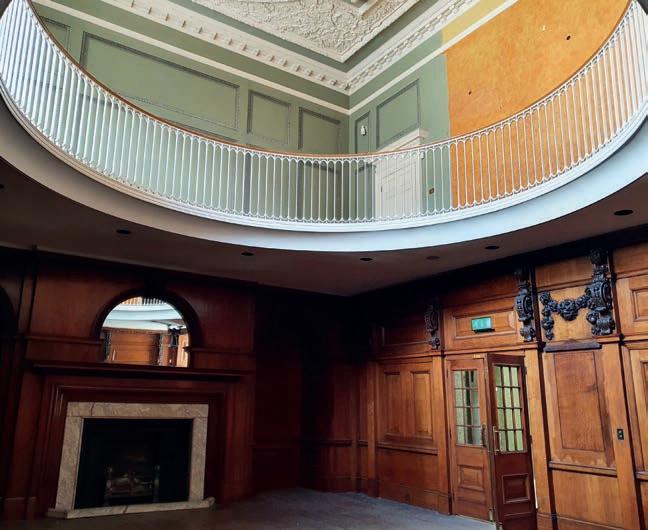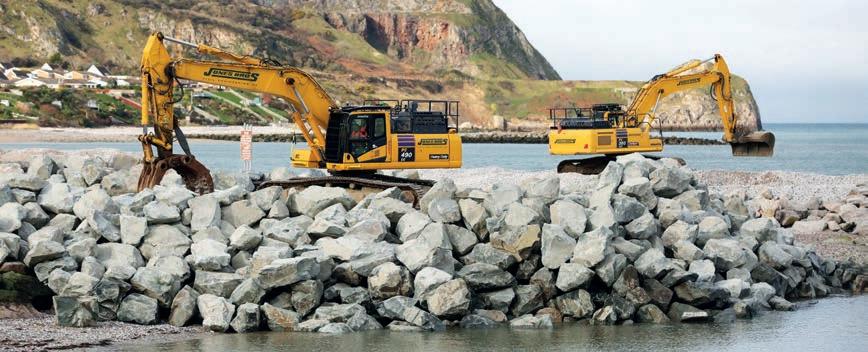
CONSTRUCTION MANAGEMENT PRODUCT SAFETY | FILM STUDIO CONSTRUCTION | ART OF BUILDING IN CHINA constructionmanagement.co.uk APRIL 2023 GREENING OUR HISTORY ENGLISH HERITAGE’S RUTH KNIGHT ON DECARBONISING HISTORIC BUILDINGS
Construction’s new people development resource
Expert opinions, career case studies, practical guides and events across a range of people development topics
Women in Construction
Mental Health
Equality, Diversity & Inclusion
Apprenticeships
Social Value
Wellbeing
Learning & Training
Employee Engagement
HR Tech
Maternity & Paternity
Leadership
www.ciobpeople.com
Flexible Working Tomorrow’s Leaders

2 | CONSTRUCTION MANAGEMENT MARCH 2023




CONSTRUCTION MANAGEMENT APRIL 2023 | 3 Contents n constructionmanagement.co.uk 04/23 Contents News 04 News in pictures 06 News: CIOB calls on Gove to meet 07 News: Hackitt’s product framework 08 News: Barriers for women on site 10 Data: Industry must invest in tech The economics of the skills crisis Opinion 12 Caroline Gumble: Better client outcomes bring benefits for all 14 Alex Walker: Domestic clients need to learn the value of quality Heritage 18 English Heritage’s climate plan Ruth Knight talks carbon reduction Technical 20 Rooff restores Skinners’ Hall Challenges in the City of London Steel 26 Framing the UK’s film studios Steelwork’s leading role Global 32 Art of Building in Chengdu Winning photos are a hit in China CPD 36 Fire and smoke access solutions Fire performance with Access 360 Legal 42 Contract clinic with Helen Johnson Planning for material fluctuations Partnership 44 Digital Construction Week 2023 Five highlights at ExCeL in May Careers & Recruitment 46 ‘Fellowship changes your mindset’ Paul Vega on getting his FCIOB Community 48 New digital resources for clients 49 CIOB graduates at Clothworkers’ 50 Firm helps trainees into work 51 Conservation conference line-up 54 Wolverhampton University CPD 55 Gilbert-Ash leads at Theatr Clwyd 56 Unlocking new productivity levels Diary dates 58 What’s on over the next month Highlights from CIOB Events 51 20 26 18
Bridging the gap
Mabey Hire has installed a temporary bridge across the River Derwent, despite complex access challenges and space constraints, reconnecting the village of Darley Abbey in Derbyshire with local businesses. At one point, part of the crane was just a couple of metres away from a resident’s front door.

Bots united
During ConExpo in Las Vegas, Advanced Construction Robotics launched IronBot, a machine that helps construction teams by lifting, carrying and placing up to 2,270kg bundles of rebar. Combined with rebartying robot TyBot, it can provide 50% schedule savings during rebar installation, the company claims.

4 | CONSTRUCTION MANAGEMENT APRIL 2023 n News constructionmanagement.co.uk
Planning for bad weather
Excavators at work on a new coastal defence project in Penrhyn Bay, north Wales. Civil engineering firm Jones Bros was appointed by Conwy Borough Council to deliver these multi-million-pound works to minimise the impact of stormy weather and associated coastal flooding.

It’s coming home
After a 10-year journey, the Migration Museum has secured a permanent home in central London. Danish architect 3XN has received the green light for the purpose-built space on the first three floors of a planned 21-storey student accommodation block near Tower Hill.

In the chair: Amit Oberoi has been appointed the new executive chairman of the Considerate Constructors Scheme

And the winner is… Zijing Li is one of the winners of this year’s Innovate UK’s Women in Innovation Awards. She’s the co-founder of Mimicrete, a startup implementing biomimetic self-healing concrete technologies.

CONSTRUCTION MANAGEMENT APRIL 2023 | 5 News n constructionmanagement.co.uk
Essex County Fire & Rescue inspected 152 care homes during 2018-19 and reported that more than a third (51) were unsatisfactory
CIOB asks Gove for meeting over care home fire regs

Institute steps up campaign launched by member Steven Miles and his wife, whose mother died in a care home fire.
CIOB has written to Michael Gove, Secretary of State at the Department for Levelling Up, Housing and Communities (DLUHC), requesting a meeting about fire safety rules for care homes.
The institute is supporting a campaign by member Steven Miles and his wife Claire, after her mother died in a fire at Newgrange Care Home in Hertfordshire in April 2017.
The couple have been campaigning to amend the fire safety regulations so care homes are classified as ‘higher-risk buildings’ in the Building Safety Act (CM, January 2023). They also want to change the current
By Will Mann
Building Regulations Approved Document B (ADB), which governs fire safety and currently provides no recommendation for sprinklers to be included in care homes.
In the letter, CIOB director of policy, external affairs and research Eddie Tuttle said: “Under the act, care homes are defined as ‘in scope’ of the new building safety regime during design and construction but not during occupation. While we understand the reasoning, we support Steven and Claire in their conclusion that the vulnerable nature of care home occupants means greater care and consideration needs to be given to regulation of safety in these buildings.
We would like to formally invite you, or any relevant officials, to meet with Steven and Claire so that they can brief you further on the work they have been doing Eddie
Tuttle, CIOB
“We would like to formally invite you, or any relevant officials, at the Department to meet with Steven and Claire so that they can brief you further on the work that they have been doing to campaign for greater fire safety regulations in care homes.
“Their harrowing experience brings home the importance of building safety and the laws that enforce it.”
DLUHC is undertaking a technical review of ADB and opened a consultation on care home sprinklers in January, saying it was “minded… to recommend sprinklers in all care homes, irrespective of height”.
After the Newgrange fire, coroner Geoffrey Sullivan said in his report that all witnesses had “expressed concern that sprinkler systems are not mandatory requirement for care homes”. He added that he was surprised that the definition of higherrisk buildings focused on height and did not give due consideration to the risk associated with the occupants.
Newgrange Care Home has since been rebuilt without any sprinklers, although the building does meet required fire safety regulations.
Since the Mileses’ campaign started, inspections by the London Fire Brigade during 2018-19 across 177 care homes found that more than half needed to make fire safety improvements. Essex County Fire & Rescue inspected 152 care homes during the same period and reported that more than a third (51) were unsatisfactory. ●
6 | CONSTRUCTION MANAGEMENT APRIL 2023 n News constructionmanagement.co.uk
Steven and Claire Miles have been campaigning to amend the fire safety regulations
51
Hackitt sets out new performance framework for construction products
As chair of the working group that created the framework, Dame Judith Hackitt tells Will Mann how it will plug gaps in the current regulatory system

Dame Judith Hackitt has unveiled a new global framework for construction product performance and expects the UK government to follow its recommendations.
“The framework has been three years in the making and brings together expert views on construction products from all round the world,” she told CM. “It provides a means for any country to assess its products regulatory system and identify where it is weak and could be improved. It’s a really important tool.”
Hackitt chaired the International Building Quality Centre working group which has created the Building Products Performance Good Practice Regulatory Framework. It was set up after high-profile building safety incidents which brought into question the reliability of product information. The framework aims to give confidence in product performance among regulators, practitioners, industry and consumers.
“Building products performance is a complex subject involving supply chains that stretch around the world and where different jurisdictions already employ different approaches to regulation, compliance and conformance testing,” Hackitt said.
“There is no ‘one size fits all’ approach and no country is starting from a position of zero regulation, so the framework needs to be applied in context. We know we have a problem with this in the UK. So now we should look at the framework and identify
where the gaps are and what is appropriate for our regulatory system.”
Hackitt, who led the post-Grenfell Independent Review of Building Regulations and Fire Safety and now chairs the UK’s Industry Safety Steering Group (ISSG), believes product systems are of particular concern.
“Buildings comprise potentially thousands of components, making up products and systems that are in many cases complex and interdependent,” she said. “These products therefore have a huge bearing on the performance and safety of a building.
“In this country, we’ve learnt the hard lesson of testing the individual elements of cladding systems which do not give you any clue as to how the whole system will perform in practice.”
Paul Nash, former chair of CIOB’s quality commission and a member of the ISSG, said: “This is a complex subject, and the working group is to be congratulated for producing a framework that is comprehensive and that manages to articulate the ‘elements’ that define good practice so clearly.
“It is particularly relevant given that the report of the Independent Review of the Construction Products Testing Regime commissioned by the government is expected to be published shortly, and will focus attention on the need for change in the way that products are tested and certified.” ● For a longer version of this article, go to www.constructionmanagement.co.uk.
CONSTRUCTION MANAGEMENT APRIL 2023 | 7 News n constructionmanagement.co.uk
Dame Judith
Hackitt:
“It’s
a really important tool”
The framework has been three years in the making and brings together expert views on construction products from all round the world Dame Judith Hackitt
JULIE KIM
Sign up for news, interviews, expert guides, case studies and much more at: www.ciobpeople.com/newsletter
Tackling ‘extraordinary’ misconceptions about women on site
Females in site-based construction roles often have to overcome barriers and can find themselves battling ‘imposter syndrome’. Nadine Buddoo reports
People often look to the oldest man in the group and assume he is in charge or I’m there for the admin Amelia Morrison, Cliveden Conservation
Morrison also admitted that she has experienced ‘imposter syndrome’ when faced with these challenges on site. “Sometimes you have to fake the confidence – fake it until you make it.”
She added that sheer grit is crucial to overcoming this self-doubt and carving out a successful career in construction. “The work can be tough and the environment can be tough. Remaining determined is key to success in the role,” she said Morrison was speaking to CM’s sister publication CIOB People about the issues often faced by women in the sector, as well as the diverse skill sets required to deliver complex heritage conservation projects.
Working on a construction site as a woman can feel like a “sociology experiment”, according to one female stonemason.
To mark International Women’s Day (8 March), Amelia Morrison, who works for specialist contractor Cliveden Conservation, outlined her experiences in construction and the varied responses from male counterparts she meets on site.

“The assumptions that people sometimes make about women on site can be extraordinary. People often look to the oldest man in the group and assume he is in charge or I’m there for the admin,” she said. “It can be quite interesting seeing people’s reactions when they realise they are wrong. It’s like watching a little sociology experiment every day.”
Despite the challenges, Morrison explained that she has found great support among her colleagues within the business – both male and female.
“I work with great colleagues who trust me and I trust them. That really helps to boost your confidence in the role,” she said. ●
To read more about Morrison’s experiences and those of other women in conservation, visit www.ciobpeople.com.
8 | CONSTRUCTION MANAGEMENT APRIL 2023 n News constructionmanagement.co.uk
Amelia Morrison: “Sometimes you have to fake the confidence – fake it until you make it”
Construction’s new people development resource
CIOB People weekly newsletter
@

Construction must invest in tech to optimise a shrinking workforce

Digital transformation of the built environment is an urgent necessity given the industry’s skills crisis, says Ben Craven

The challenge of skills shortages in the UK construction industry is not new, however it is becoming more and more apparent every year. Nationally, the government has made headlines with its approach to encourage retirees from various industries back into work. Even if successful, this is only a quick fix that does not deal with much deeper structural issues in the sector.
The construction sector as a whole is ageing. Data from the Office for National Statistics in 2022 Q4 revealed that more than half of workers in the industry are over 45 – with 11.2% being less than six years away from receiving a state pension.
A decade ago the age distribution of the workforce was more balanced: 7.9% of workers in Q4 of 2012 were nearing retirement and 18.2% were under 30.
The rising age of the average construction worker isn’t a problem in and of itself, provided there’s a pipeline of new talent entering the workforce as people move towards retirement.
However, this trend is more concerning given the increase in early retirement prompted by the pandemic. With more people leaving the workforce earlier, the number of people employed in construction is falling, and this is being exacerbated by a shrinking foreign workforce following the UK’s exit from the EU. Overall, some 250,000 workers have voluntarily left the sector since the start of 2019.
With only a drip feed of new workers to replace them, and an already tight labour market – reflected by a low industry unemployment rate – firms must adapt to this shifting and declining skills pool. Skills remain in high demand and, though the UK is set
Unless firms focus on improving labour efficiency, they risk being caught out by an even more constrained market once recovery gets underway and demand again rises
to enter a downturn, the contraction in Gross Domestic Product is not expected to be particularly severe or to last beyond 2024 Q3. This means that, even though there is little expectation that it will reduce substantially, the labour market will naturally slacken.
Unless firms focus on improving labour efficiency, they risk being caught out by an even more constrained market once recovery gets underway and demand again rises.
One answer lies in productivity and boosting the industry’s capacity to do more with less labour.
Investment in technology and digitalisation will be critical. Artificial intelligence like OpenAI’s ChatGPT has captured the world’s imagination and tools like this have considerable potential for construction – from automating processes to driverless plant and accelerating the use of modern methods of construction.
The sector is a long way from full automation – personal experience will remain invaluable in construction environments when it comes to design, delivery and risk management. However, there is a significant opportunity to blend skilled people with new technology – addressing a skills gap and improving outcomes too.
Ben Craven is an associate director and lead economist at Turner & Townsend.
10 | CONSTRUCTION MANAGEMENT APRIL 2023 n Data constructionmanagement.co.uk
Percentage of construction workers less than six years away from receiving a state pension, according to ONS data

11.2
Difference between proportion of construction workers at each age range from 2012 Q4 and 2022 Q4

CONSTRUCTION MANAGEMENT APRIL 2023 | 11 Data n constructionmanagement.co.uk
60-64 years 55-59 years 50-54 years 45-49 years 40-44 years 35-39 years 30-34 years 25-29 years 20-24 years 16-19 years SOURCE: NATIONAL ONLINE MANPOWER INFORMATION SERVICE 7.9 10.9 12.5 13.5 14.2 11.5 11.3 9.2 6.9 2.0 11.2 15.4 13.6 12.2 9.9 11.6 10.1 7.2 6.4 2.5 n 2012 Q4 n 2022 Q4 Unemployment in construction 180 160 140 120 100 80 60 40 20 0 2012 Q4 2015 Q2 2017 Q4 2020 Q2 2022 Q4 SOURCE: OFFICE FOR NATIONAL STATISTICS
People (thousands) Construction – long term Construction – last job
Caroline Gumble CIOB
Construction is a team sport – and clients are part of that

CIOB is working with clients to help them achieve better project outcomes, and the whole industry will benefit, writes Caroline
 Gumble
Gumble
The work Mike Foy started is now an area of strategic focus, with the goal of helping clients to achieve better project outcomes for them, the environment and society at large
right language. Let’s avoid the jargon and try to speak the same language. This was emphasised by Jennifer Makkreel, deputy head of capital projects at University of Oxford, in response to a question about what academia can do to support built environment students in being better as clients or with clients. Jennifer commented that we’re in “a people business” and good communication skills are very valuable.
CIOB’s immediate past president, Mike Foy OBE, chose client and client-contractor relationships as the theme for his presidential term, making the case that “clients are key to all our big challenges as an industry”. The continuing drive to raise quality standards, the push to achieve net zero, encouraging innovation, delivering greater diversity – these are just some of the issues where clients can potentially be a force for good.
If you read the interview with my colleague Linda Stevens, head of client development, (CM, January), you’ll know that the work Mike started is now an area of strategic focus, with the goal of helping clients to achieve better project outcomes for them, the environment and society at large.
The great news is that we’ve now published the first of our online resources for clients (see also p46), including a guide aimed at less experienced clients who are given responsibility for a large construction project. It will also be useful for SMEs working in a third-party capacity.
To launch the guide, we went to FutureBuild in London a few weeks ago, hosting a panel discussion on ‘What Construction Clients Want and Need’. It was a great session, highlighting the range of issues where client decisions can have an impact.
Our panellists offered insights and practical advice. David Haimes, formerly programme director with Highways England, noted that it’s so simple but so important to talk the
Neil Pennell, head of design innovation at Landsec, offered up a key point, saying we “need to have trust to collaborate”, while also being mindful that our sector isn’t always set up to facilitate that. There was also talk of construction being a “team sport”, which I loved hearing.
You can download the client guide – for free – from our website. Our content to support clients will continue to develop over time so watch this space for more resources.
My thanks to all those who supported our launch event and to all the members who contributed to the development of our new guide. ● Caroline Gumble is CEO of CIOB. Download the CIOB Client Guide at www.ciob.org.
12 | CONSTRUCTION MANAGEMENT APRIL 2023 n Opinion constructionmanagement.co.uk
Landsec’s The Forge is a great example of client innovation and won the Digital Construction Awards project of the year in 2022
 Alex Walker MCIOB APM Walker Construction
Alex Walker MCIOB APM Walker Construction
Homeowners place emphasis on the qualifications of architects, but this is not always the case with builders
but this is not always the case with builders. This highlights a need for better education about the benefits of working with a chartered builder.
How can chartered builders educate domestic clients?

The domestic building sector doesn’t always value qualified building professionals. Alex Walker wants to change that perception and raise build quality standards for homeowners
As a chartered builder who works directly with homeowners, I have observed that many domestic clients do not distinguish between a CIOB member and an unregulated builder.
In fact, most homeowners assume that all builders are the same and do not seek the value of working with a qualified professional. This is a significant issue that needs to be addressed.
There are no statistics on the number of chartered professionals working in domestic building. However, in my experience, the number seems relatively small and there is a real lack of awareness among homeowners about the value of hiring a CIOB member.
One of the most common issues I encounter when talking to clients about the benefits of working with a chartered builder is their focus on price over professionalism.
While it is understandable that clients want to keep costs down, it is important to educate them about the risks of using an unqualified builder: poor workmanship, unexpected costs and potential legal issues. By using a CIOB member, clients can be assured of professionalism, which can save time and money in the long run, while reducing risks throughout.
Interestingly, homeowners seem to place emphasis on the qualifications of architects when choosing professionals for building projects,
Last year my company built a contemporary new-build family home for a very risk-averse and budgetconscious domestic client. Rather than strip away the character of the build through heavy-handed value engineering, I identified that the key to maintaining a high-end finish on a budget would require deeper collaboration with the client, a flexible specification and a lot of trust.
The project was administered on a ‘cost-plus’ basis and by using CIOB’s Code of Practice as a framework for process and project management. The family home was delivered on time and budget, even through a tough period of inflation. The client was left in no doubt of the value added by using a chartered builder.

How do we educate domestic clients about the benefits of using qualified professional builders? This could include wider promotion, greater regulation and legislation to ensure that homeowners are protected. Additionally, we must address the perception that professionalism only applies to architects or consultants.
By emphasising the value of working with qualified builders, we can help to raise standards and ensure clients receive the highquality workmanship and project management they deserve. ● Alex Walker MCIOB runs his own building company, APM Walker Construction.
14 | CONSTRUCTION MANAGEMENT APRIL 2023 n Opinion constructionmanagement.co.uk
A contemporary family home built by APM Walker Construction

Greening our history
How do you decarbonise historic buildings? Will Mann meets English Heritage head of climate and sustainability Ruth Knight to hear about its climate action plan
From prehistory to the Cold War, English Heritage cares for over 400 buildings and monuments. These range from the recently acquired Thornborough Henges in Ripon – the ‘Stonehenge of the North’ – to York’s nuclear bunker, which was in use as recently as 1991.
The direct carbon footprint of English Heritage’s estate is a sizeable 4,400 tonnes of CO2 a year (scope 1 and 2 emissions) – and it has set a tough target of a 20% reduction by 2025. The organisation aims to reach net zero by 2040.
“Our carbon reduction programme is ambitious,” says head of climate and sustainability Ruth Knight, who will be speaking at CIOB’s annual conservation conference on 25 April.
And this isn’t just about specialist heritage skills, she adds. “To achieve our goals, we will be tapping into the wider expertise of the construction industry – modular building, digital innovation, renewable energy installations.”
Knight joined English Heritage in July 2021 and her first task was to compile its climate action plan for 2022-25. This meant crunching the data about its carbon footprint.
“We found that 10 sites accounted for 52% of all our carbon emissions, among them Dover Castle and Osborne House on the Isle of Wight,” she says.
Half its direct emissions come from electricity and another 26% from gas so energy efficiency is a priority over the next two years. “Be lean, be mean, be green – that’s the mantra,” Knight says.
She acknowledges there is a ‘transition risk’ to be navigated: “We have to walk a fine line – reducing carbon emissions and complying with the legislation, while conserving our historic places and maintaining our reputation as a responsible charity.”
Carbon reduction
The carbon reduction programme is now well underway. Electrical upgrades, window repair and insulation, plus more onsite generation of green energy are all in the plan to reach the 2025 target.
We will be tapping into the wider expertise of the construction industry – modular building, digital innovation, renewable energy installations
Ruth Knight, English Heritage
The Victorian-era Gardeners House at Audley End is currently being renovated with an air source heat pump and EV charger fitted. Airbnb has supported the restoration and refurbishment of the property and English Heritage will let it out as one of the charity’s holiday cottages.
Larger sites such as Kenilworth Castle and the Audley End country house in Essex will have their own master plans with climate action woven in. At Clifford’s Tower in York, which reopened last year after renovations, consultant Ramboll carried out a life cycle assessment to help inform future project approaches.
Strange as it may seem for a heritage body, there will be some new build. “We have visitor centres on our sites which are quite basic and need replacing,” Knight explains.
Ruth Knight: “Be lean, be mean, be green – that’s the mantra”
“These could be modular or buildings that are easily reusable. We’ve been looking at Landsec’s ‘kit of parts’ approach [used on The Forge development in Southwark] for ideas.
“We recently completed a new visitor building at Old Wardour
16 | CONSTRUCTION MANAGEMENT APRIL 2023 n Heritage constructionmanagement.co.uk
PHOTOGRAPHY: JULIE KIM

In numbers:
English Heritage Climate
Action Plan 2022-25
400+
Number of buildings and monuments
4,400
Tonnes of CO2 produced a year (scope 1 and 2), direct carbon footprint (2019-20 baseline)
66,200
Tonnes of CO2 produced a year (scope 1, 2 and 3), indirect carbon footprint including visitor travel
20
Percentage reduction target in scope 1 and 2 building carbon emissions by 2025
2040
Net zero target
Castle in Wiltshire. It’s only a small building, but we’ve minimised embodied carbon in the materials, and fitted a heat pump, electrical heating and a green roof.”
The difficulty with some new technologies is making them work in historic buildings, Knight acknowledges.
“For example, heat pumps have to be able to work with historic radiators,” she says.
“Fitting insulation is more invasive, so you need skilled contractors who will understand the sensitivity of the building fabric. Also, we usually only install small sections of targeted insulation, rather than a complete
envelope, because otherwise problems like mould growth can occur because the building can’t breathe.”
Traditional skills can also be in short supply. “The number of people who can do flint knapping, for example, is very limited, but we have a lot of ruins in East Anglia which need these specialist conservation skills,” Knight says.
“And on a general point, our sustainability strategy will be about trying to use local materials, local crafts, local skills wherever we can.”
English Heritage will expect 80% of its large suppliers to have their own public net zero commitments and action plans.
Rock armour has been installed to protect Hurst Castle against rising sea levels
Climate resilience
A broader challenge is climate resilience work, where English Heritage will be working with other stakeholders.
Hurst Castle sits on a narrow spit of land in Hampshire and in February 2021 a section of wall collapsed after the sea exposed and undercut its foundations.
“It is an example of how our coastline sites are struggling with sea level rise and extreme weather,” Knight explains. “We have put in rock armour at Hurst but we need to make a decision with Historic England about what we do next and this involves a wider discussion with

18 | CONSTRUCTION MANAGEMENT APRIL 2023 n Heritage constructionmanagement.co.uk
We’ve started modelling climate risk across all our sites, which allows us to identify the sites which are the most vulnerable and exposed to climate hazards like extreme rainfall
Ruth Knight, English Heritage

the community and other bodies including the Environment Agency.
“We’ve started modelling climate risk across all our sites, which allows us to identify the sites which are the most vulnerable and exposed to climate hazards like extreme rainfall.”
Next, Knight wants to create digital twins to model different climate change scenarios. “If we created a digital twin of one of our mansion houses, we could then see, for example, the impact of extreme rainfall on drainage, and assess whether we need to change the maintenance regime,” she explains.
Some unused historic building features may help with the carbon reduction strategy, Knight adds.
“Where window shutters have been taken off buildings, could they be restored to provide solar shading? Could we reopen up chimneys to allow natural ventilation?” she says.
“Our climate action plan is about taking a holistic view of every building and identifying opportunities – this is where reaching out to see what we can learn from the wider construction industry is so important.” ●
The CIOB Conservation Conference, New Ideas for Tough Times, takes place on 25 April at One Moorgate Place, London EC2R 6EA. Further information on p51 and at: www.ciob.org/events.
CONSTRUCTION MANAGEMENT APRIL 2023 | 19 Heritage n constructionmanagement.co.uk
Heart of the City
Restoring and modernising historic buildings in the City of London poses a multitude of heritage and access challenges, as Kristina Smith finds out on a visit to the 17th century Skinners’ Hall

20 | CONSTRUCTION MANAGEMENT APRIL 2023 n Technical constructionmanagement.co.uk
Temporary roofs cover the historic Skinners’ Hall site in the heart of the City of London
There has been an exciting discovery in the basement of the Skinners’ Hall: a medieval culvert which once carried the Walbrook River through the City of London. The river was a major factor in the siting of the Worshipful Company of Skinners here back in the 10th century, perhaps even earlier.
This is both good news and bad news for contractor Rooff which is carrying out a £17m restoration and modernisation contract for the Worshipful Company of Skinners. It was important to locate the culvert and determine its condition so that the position of the piles for a new lift shaft could be set, but the discovery of any element of historical interest triggers a series of actions which aim to record and, where appropriate, conserve what has been found.
Skinners’ Hall is a Grade I-listed building, with some of its basement dating from before the Great Fire of London in 1666. It is designated a scheduled ancient monument, which means it has to be treated with respect and care by law. There have been various rebuilds and alterations over the centuries, leaving behind a fascinating record of both building practices through time and the activities of the Skinners.
“This is at a completely different end of the spectrum to new build,” says Karl Patten, project manager at Rooff. “You need to have the correct mindset and appetite.”
The building is a scheduled monument. We cannot take the roof off and hope it doesn’t rain. And if you have a temporary roof, how do you use the tower crane?
Tony Pearce, Rooff
The vision for the project is ambitious: to strip out the clutter internally so that the story of the building is more visible, reclaiming some of the larger spaces, while at the same time improving access, circulation and the energy efficiency of the building. Over the centuries, the Skinners’ activities have evolved from fur and leather trading to philanthropy and education. Revenues from the building will go towards supporting eight schools, helping disadvantaged young people – and funding the ongoing upkeep and preservation of the Skinners’ Hall complex.
Added to the historic challenges of this project is the location of the hall, close to Cannon Street rail and underground station. Locked in by buildings on two of its sides, access to the Skinners’ site is via an entrance on Dowgate Hill or via a narrow lane, College Street, running along its south side. The only outside area for materials or plant storage is a small courtyard in front of the College Street entrance.

“Logistics was the key to unlocking this project, and it helped us win the contract,” says Rooff development director Steve Drury FCIOB.
Through discussions with the City of London Corporation and Transport for London – whose tube line runs beneath the area, leading to loading restrictions for some of the roads – Rooff agreed a route into the site and was allowed to close a short section of College Street for outside working space. However, it was not feasible to use a tower crane due to the requirement for a temporary roof.
“The building is a scheduled monument. We cannot take the roof off and hope it doesn’t rain,” explains Rooff construction director Tony Pearce. “And if you have a temporary roof, how do you use the tower crane?”
Working with Inner City Scaffolding, Rooff devised an ingenious system for lifting and distributing materials and equipment. A 2,500kg-capacity goods hoist brings materials up to roof level, which is boarded out from roof
CONSTRUCTION MANAGEMENT APRIL 2023 | 21 Technical n constructionmanagement.co.uk
Plan of the Skinners’ Hall project
1666
Skinners’ Hall is a Grade I-listed building. Some of its basement dates from before the Great Fire of London in 1666
to roof. The whole site is covered in a temporary roof, with a 1 tonne-capacity lifting beam slung underneath the Haki roof cassettes to move materials around.
Four projects in one
There are four main buildings in the Skinners’ Hall complex, all different ages (see plan, p21). The Great Hall
and Outer Hall were completed by 1672. The Court Room was built around 1680 and the Dowgate Range 100 years later. Finally, Walbrook House was added in 1989.
As well as more event space, the new layouts, designed by 6a Architects, will mean improved member areas, staff accommodation and new offices. Works to improve
Skinners’ Hall
Client: Worshipful Company of Skinners
Contractor: Rooff
Project manager and cost consultant: Synergy
Architect: 6a Architects
Structural engineer: Price & Myers Building services: Ritchie+Daffin
Contract: JCT Standard Building Contract with Quantities
Programme: May 2022 – May 2024 (104 weeks)
accessibility include the installation of four new Atlantic Blue limestone staircases, all cantilevered.
A fifth building, linking Dowgate Range and Outer Hall, was damaged during bombing in the Second World War. Rooff will replace its top two storeys with offices and accommodation. That building, with its new sawtooth roof, will provide a backdrop to the renewed Courtyard. New roofs and walls are generously packed with wood fibre insulation, which isn’t possible for the existing fabric due to its Grade-I listed status. The vaulted basement, with ancient stone double and quatro vaults, was used for storage until now. This is being reinvented to provide a historic dining area. The upgrade in energy efficiency will see gas banished from the buildings and replaced by air source heat pumps. Fireplaces and chimneys will be repurposed as inlets and outlets for fresh air, with new cables, ductwork, pipes sensitively threaded into the fabric of the old buildings.
Building through time
In the historic basement, new services including underfloor heating have been installed. On completion, it will be used as a dining area
Walking round the site with Pearce is like a having a mini masterclass in building. (How many readers are familiar with a bressummer beam, for example?). Pearce pored over the 600 drawings that came with the tender, 450 of them architectural, and he seems to have them all stored in his head. He frequently peels off to consult with tradespeople.
In the basement, the juxtaposition of old and new, conservation and energy transformation is very evident. Beneath the vaulted ceilings, two operatives are laying down underfloor heating. Pearce pulls back a geotextile sheet to


22 | CONSTRUCTION MANAGEMENT APRIL 2023 n Technical constructionmanagement.co.uk
reveal a 120mm layer of insulating recycled glass aggregate, with the pipes to be encapsulated in a limecrete floor.
Rooff started on site in May 2022. Installing the temporary roof and its supporting scaffolding took five months. The contractor has also stripped out partitions and other additions made mostly in the 20th century.
“Our brief was to get back to the bare bones but work like this cannot just be done over a few weeks,” explains Patten. “We have to observe what we are finding, report to the architect who then reports to the heritage consultant and Historic England.”
MOLA (Museum of London Archaeology) has a watching brief. On the day of CM’s visit, MOLA senior archaeologist David Sankey was observing as an operative painstakingly stitch-drilled through slabs of concrete laid in the 1980s close to the Walbrook culvert.
“The culvert carried the stream which ran just north of the city wall at Moorgate,” explains Sankey. “By the late Middle Ages a lot of it was in culverts, so this is a late medieval culvert and very fragile.”
Rooff removed a 1980s staircase to expose the culvert. A new lift shaft will go in, requiring a mini piling rig to be painstakingly
The Outer Hall prior to redecorating and restoration

We have to observe what we are finding, report to the architect who then reports to the heritage consultant and Historic England
Karl Patten, Rooff
manoeuvred into the space. Before that happens, Rooff needs to test the capacity of the existing piles. And before that can happen, there are more potential archaeological findings to be investigated.
The laying of the limecrete floor was scheduled for the day after our visit to allow the piling rig to be brought in. But now things are on
CONSTRUCTION MANAGEMENT APRIL 2023 | 23 Technical n constructionmanagement.co.uk
600
Over 600 drawings came with the Skinners’ Hall tender
hold, while decisions are taken on the conservation of the culvert and further archaeological investigations take place.
Meanwhile, up at roof level, courtesy of the scaffold, ongoing works to the various roofs can be viewed. The tiles from part of the Dowgate Range roof have been taken off, a breathable membrane and battens installed with the old tiles piled up, ready to be reinstalled. At the north end of the range, carpenters are working on the opening for an elliptical rooflight which sits over the historic staircase.
Single-glazed Georgian wire glass must be replaced with curved
Long careers at Rooff
Two directors working on the project have been with the firm since 1985

CGI showing how Rooff will replace the top two storeys of a bomb-damaged building and add a new sawtooth roof facing the courtyard

double-glazed panes, which Pearce explains are “very unusual”.
The roof of the Great Hall will also be renewed. But the Outer Hall’s pitched roof will be transformed to a flat one and used to house plant, including the air source heat pumps, shielded from view by a screen which will also limit noise. With an ornate plaster ceiling beneath, this has been a major engineering feat, involving the transfer of the ceiling support from timbers to a new steel frame. A second frame installed above that takes the weight of the plant.
Juggling act
On a job like Skinners’ Hall, it is a juggling act for Rooff to keep the project moving forward so there is enough work for their subcontractors. “We don’t want too many interruptions to workflow because you need to keep the labour on site,” explains Drury.
Changes in programme, such as those related to the Walbrook culvert, have knock-on effects elsewhere. They also mean that material deliveries build up, all stored within the building alongside historic elements such as the floorboards, which have each been carefully numbered and stacked.
Patten enjoys the works though. “We are proud that we are one of the few remaining old-school building contractors,” he says. ●
Rooff’s development director Steve Drury FCIOB and its construction director Tony Pearce both joined the company in 1985. Project lead Karl Patten joined the company 13 years later and, bar a very short spell with another contractor, has been there ever since, gaining a degree in Design and Construction Management while working.
“It sounds corny to say, but it is like being in a family working here,” says Patten. “It’s not just about getting a pay cheque every month.”
It’s fair to say that all three of them love heritage work. Drury cut his teeth on projects such as Skinners’ Hall as a trainee surveyor and describes himself as an “amateur historian”. Pearce is a construction enthusiast who likes to get his teeth into technical challenges. And Patten gets a kick out of the complexities of a heritage refurbishment.
24 | CONSTRUCTION MANAGEMENT APRIL 2023 n Technical constructionmanagement.co.uk
Tony Pearce (left) and Steve Drury joined Rooff as manager and trainee QS in the same year
We don’t want too many interruptions to workflow because you need to keep the labour on site Steve Drury, Rooff
When the letters after your name spell out professional
For almost 200 years CIOB has set the standards that industry professionals follow. And by becoming Chartered, you can set the standards for the future. That’s why MCIOB after your name, really does spell out professionalism.
Find your path to being qualified at CIOB.org

Steelwork’s leading role

26 | CONSTRUCTION MANAGEMENT APRIL 2023 n Steel constructionmanagement.co.uk
Flexibility, speed of construction and large column-free spaces mean steel is the preferred framing solution for the UK’s booming film and TV studio sector. By Martin Cooper

CONSTRUCTION MANAGEMENT APRIL 2023 | 27 Steel n constructionmanagement.co.uk
The UK’s film and TV sector is booming. Recent research by ScreenSkills and the British Film Institute says the sector is riding the crest of a wave and estimates that continued growth will require the equivalent of between 15,130 and 20,770 additional fulltime crew within three years.
A bigger workforce is needed as an estimated 250,000 sq m of additional stage space will be available by 2025. Recent investments by the likes of Sky, Netflix, Amazon Prime, Apple TV and Disney have seen billions of pounds committed to the UK sector. Huge sums are being spent on enlarging existing studios and on
building new complexes. More than 20 new sites are in the pipeline, including an expansion of the famous Pinewood Studios and the redevelopment of the former Dagenham Ford works, with plenty more currently under construction.
Steel is playing a leading role in this sector as the majority of film and TV studios in the UK are built using a steel-framed solution.
“Structural steelwork is ideal for the construction of studios as the material can provide long clear spans and is quick to erect,” says Fairhurst partner Hugh O’Neill.
“In simple terms, the studios can be thought of as hangars with increased acoustic insulation, as
Paola
Steel is lightweight and efficient and allowed an elegant structural design at Kelvin Hall
Nine main steelframed structures are being built for Sky Studios, Elstree
 Paola Pappas, Woolgar Hunter
Paola Pappas, Woolgar Hunter

they both have similar frames with roof trusses. The trusses form the important open-plan interiors and in the sound stages they are also used to support multiple pieces of equipment, alongside access gantries and walkways.
“The driver is to create the open space to allow flexibility of use by the set designers. Building the superstructure quickly allows earlier commencement of the follow-on fit-out works.”
Sky Studios at Elstree
Flexibility is another important attribute of steelwork, as studio buildings are quite often designed so they can be subdivided into smaller spaces if required. This has recently been highlighted at the new Sky Studios project at Elstree, where a number of stage buildings have demountable steel walls.
Located just north of London, Elstree has been home to a significant slice of the British film industry for more than 100 years. This current project will be one
28 | CONSTRUCTION MANAGEMENT APRIL 2023 n Steel constructionmanagement.co.uk
Pappas is project engineer for the Kelvin Hall hub in Glasgow
of the largest. Housing 13 sound stages, it will be host to a range of film and TV productions from Sky Studios and NBCUniversal.
Once operational, the scheme will have the capacity to host productions from third-party producers, allowing the European and International creative community to do their best work in the UK.
There are nine main steel-framed buildings in total: eight stage and production structures and a multistorey car park. Working on behalf of main contractor BAM Construction, Severfeld fabricated, supplied and erected 6,500 tonnes of steelwork for this prestigious scheme.
The stage studio buildings are up to 54m wide, with column-free internal spans formed with long steel trusses. Three of the studios have demountable partitions to allow them to be subdivided into smaller spaces, with two structures having the flexibility to be reconfigured into four studios instead of one large space.

“The demountable walls can be up to 1m thick as they are acoustically treated partitions, but they can be
removed, albeit in a few days or so,” adds O’Neill. “A steel design gives the project this desired flexibility in terms of functional use of the space.”
In line with Sky’s commitment to become net zero carbon by 2030, and matching developer Legal & General’s drive to deliver major ESG (environmental, social and governance) projects, Sky Studios Elstree has the ambition to become the most sustainable film and TV production studio in the world.
As part of design process, the businesses have actively looked at all sustainable development opportunities, with the project using reduced embodied carbon in construction. The site will only use renewable energy, with much of this coming from onsite solar panels.
“All framing solutions were looked at and steelwork was the best option. Once the initial design was finalised, we then undertook a carbon reduction programme, that involved value engineering all of the steelwork to create the leanest and most efficient frames,” explains O’Neill.
More than 20 new production studios are in the
pipeline
Glasgow’s Kelvin Hall film hub
Showing the nationwide scope of the sector’s current boom, up in Glasgow a new film and broadcast hub is being constructed at the city’s famous Kelvin Hall.
Built in 1918 then rebuilt in 1926‑27 following a fire, Kelvin Hall has had a varied existence, housing large national and international exhibitions as well as motor shows, sporting events and classical and rock concerts. It was also converted to a barrage balloon factory during the Second World War.
Jump forward to 2023 and Kelvin Hall – which closed its doors in 2014 – is in the middle of a redevelopment programme that has already seen two of its four halls return to life as upgraded exhibition space, a sports centre and a health and fitness club.
Phase two is now underway, which includes the construction of the steel-framed Kelvin Hall Film & Broadcast Hub, in hall number three.
Once complete, the facility will be operated by BBC Studioworks, a commercial subsidiary of the BBC

CONSTRUCTION MANAGEMENT APRIL 2023 | 29 Steel n constructionmanagement.co.uk
20
The BBC Studioworks facility at Kelvin Hall used 300 tonnes of steel CGI cross section of the Kelvin Hall studios
which provides studios and postproduction services to the industry.
Co-funded by Glasgow City Council and the Scottish government, the facility will house a wide array of entertainment shows across multiple genres. It will become the Scottish hub for major TV broadcasters and production companies and will help meet the growing demand for TV shows in Scotland, providing studio space and post-production services to companies including the BBC, ITV, STV, Sky, Channel 4 and Netflix.
Working on behalf of main contractor City Building, Hescott Engineering erected 300 tonnes of steelwork for this project.
Explaining the choice of a steel design, Woolgar Hunter project engineer Paola Pappas says: “Steel is lightweight and efficient and allowed an elegant structural design.
“Essentially, the building is a braced box with perimeter steel bracing, with secondary and tertiary steel supporting layers for TV cameras and access.”
The steel frame is divided into two parts that are acoustically isolated from each other: a column-free studio measuring 28m long x 30m wide, and a three-storey element that will contain recording and production suites, costume rooms, green rooms and workshops.
Liverpool’s The Depot
Another steel-framed project that recently opened is The Depot in Liverpool, built by Morgan Sindall. Already favoured by filmmakers for doubling-up for locations such as New York and London, Liverpool is said to be most filmed city in the UK. Requiring 220 tonnes of structural steelwork, which was erected by Leach Structural Steelwork, this project comprises two 1,850 sq m soundproofed film and TV production units.
Flexibility is at the heart of this project’s design, as the two steel-framed studio buildings have large internal spaces that can be utilised for a variety of productions
Our ambitious plans are to help make our region the ‘Hollywood of the north’ Steve
and even sub-divided into smaller zones, if required.
A steel-framed design proved the most efficient solution as the project team wanted a quick construction programme, a lightweight frame and two buildings containing large column-free spaces. All of the steelwork is left exposed within each of the structures, including the stability-giving bracings located at gable ends of both buildings.
Preventing noise entering and leaving the buildings is of utmost importance for film and TV studios, so the steel frame supports acoustic roof and wall cladding panels.

Steve Rotheram, metro mayor of the Liverpool City Region, said: “Our ambitious plans are to help make our region the ‘Hollywood of the north’.
“These new facilities will help us keep [film and TV productions] here and offer the full package to productions, from providing stunning filming backdrops to the more technical editing and recording work.” ●
30 | CONSTRUCTION MANAGEMENT APRIL 2023 n Steel constructionmanagement.co.uk
The Depot in Liverpool consists of two steel-framed soundproofed units
Rotheram, Liverpool City Region



Get a global view of the built environment Global Construction Review tracks the complex flows of money, ideas and talent to provide a world view of the built environment business. www.globalconstructionreview.com 81,917 unique users per month (Google analytics Jan to Dec 2022)
Art of Building is a hit in Chengdu
Rod Sweet reports on an enthusiastic reception for CIOB’s flagship photography competition in China
CIOB in China has turned the institute’s renowned online photography competition, Art of Building, into a popular live exhibition in the south-western city of Chengdu.
Art of Building celebrates the creativity of the built environment sector, the passion of the people who work in it and the impact their work has on the public.
This year’s competition received more than 1,500 entries from around the world. They were whittled down to a final 12 by judges, before the world’s public were given the chance to vote online for their favourite.

32 | CONSTRUCTION MANAGEMENT APRIL 2023 n Global constructionmanagement.co.uk
We hope this exhibition will bring people closer to the built environment, as well as celebrating the humanity behind the significant buildings
Nancy Lai, CIOB
Now, those 12 pictures and 16 from previous competitions are on display in a gallery at the Yanlord shopping centre in Chengdu’s central business district.
The exhibition was made possible by the lifting of Covid restrictions at the beginning the year.
Extended by popular demand CIOB in China initially planned for the exhibition to run from 24 February to 24 March, but sponsor Yanlord asked for it to be extended to 16 April owing to the show’s popularity.
Some 8,000 people visit the Yanlord mall every day.
“I am so glad we could have the very first offline Art of Building photography exhibition here in China,” says Nancy Lai, marketing manager for CIOB in China. “We hope this exhibition will bring people closer to the built environment, as well as celebrating the humanity behind the significant buildings.”
She adds that the exhibition has made it into local press and trendy social media channels.
“The Art of Building competition is an excellent way to highlight the built environment, not only to our members but a much broader audience in the industry and society as a whole,” says Steve Corry, CIOB’s associate director of international market development.
The exhibition in Chengdu’s Yanlord mall will run until 16 April Visitors enjoy Rong Xu’s entry ‘A lonely small pink church’

Some 8,000 people visit the Yanlord mall every day 8,000
“We are delighted on this occasion to be presenting the competition to audiences in south-west China.”
As well as the exhibition, CIOB in China organised an event entitled International Construction Projects Talent Cultivation and Professional Development on 5 March at Chengdu’s Tsutaya Bookstore.
What the people chose
Photographers Francesca Pompei of Italy and Pati John of the Netherlands each won £1,500 for winning this year’s Art of Building, which is the world’s biggest builtenvironment photography contest.
Pompei’s work, ‘White Constellation’, got the most public votes, and so won
the People’s Choice award. It depicts the UAE Pavilion at last year’s Dubai Expo, designed by Swiss-Spanish architect Santiago Calatrava.
Pompei describes the pavilion as “a symbol of resilience and of a boundless future embracing a dialogue among different cultures”.
Judges’ choice
The judges’ favourite this year was ‘My own little cosmos within reach’ by Pati John, showing the night sky from inside a shopping mall.
She describes her shot as “the most beautiful Milky Way I have seen – surrounded by amazing architectural symmetry”.
“I discovered this astonishing view looking up while I walked around the mall,” John says. “It was breathtaking so I stayed there for a long time with my tripod and ND filter to capture every detail in my long exposure shot.”
Joanna Quirk, chief operating officer at CIOB, who was on the judging panel for the competition, says: “So many finalists managed to create a sense of mood and place, it was a delight to judge the competition. Francesca’s image shows the beauty and harmony in great architecture and it is a reminder of the impact on our emotions and wellbeing that well-designed buildings can have.
“Pati John’s little cosmos shot had all the judges wowed at the tone it struck. It is a beautifully symmetrical shot and revealed a wonderful building detail that many of us might just walk by. We should look up more often and pay attention to what is around us. The night sky was the perfect backdrop for this enchanting image.” ●
CONSTRUCTION MANAGEMENT APRIL 2023 | 33 Global n constructionmanagement.co.uk


The UK's best read digital construction resource. Exclusive news, views, interviews, debate and case studies on all the latest digital technologies from 3D printing and robotics to off-site manufacturing and virtual reality. How digital technologies are creating efficiencies and productivity for firms across the supply chain from designers to contractors and product manufacturers.
A site for anyone working in digital construction from beginners through to experienced practitioners. Every part of the BIM journey provided by industry experts, software developers and industry bodies. Project stories and case studies to guide you through BIM adoption.
www.bimplus.co.uk


Fire and smoke access solutions
There are a range of specification techniques that can be applied to achieve compliant and effective fire performance for wall and ceiling access solutions. Tom Brandon explains

36 | CONSTRUCTION MANAGEMENT APRIL 2023 n CPD constructionmanagement.co.uk
Whether you are specifying riser doors, wall access panels, ceiling access panels or steel doors for a project, it is important first to understand the relevant application, its construction, technical requirements and corresponding legislation. This will enable you to achieve the correct product specification for your project. This will ensure compliance with the fire-resistance requirements for your access solutions.

What is a riser door?
A riser door enables relevant individuals to gain access to building services. Examples include electrical cupboards, service ducts or access to the rear of bathroom pods.
Above: Bi-directionally fire-tested riser doors with adjustable frames installed at 8 Bishopsgate, London
Below: Bi-directional fire testing –after testing

Unlike traditional timber doorsets, contemporary doorsets are concealed and clean, with all ironmongery elements hidden inside. They can be manufactured in continuous banks – such as triples, quads or fives – and can be engineered in length banks to allow greater access.
What is a fire door?
A fire door compartmentalises a building’s physical structure, creating a barrier that cuts off the flow of smoke and fire to separate areas. This reduces the damage caused by fire and smoke, while protecting key routes of evacuation for individuals trying to escape. It also provides emergency services with a protected route to gain access to the building. Fundamentally, fire doors are there to save lives – and, secondly, to reduce damage to the building.
It’s therefore extremely important that the manufacture, specification, installation and maintenance of fire doors are correct and that all risks have been appropriately managed.

In association with
Building
Regulations
Approved
Document B stipulates that all doorsets –all elements of the door, including the associated ironmongery – must be installed and sourced from a single source
There are multiple elements of a fire door: the door leaf, the frame and its linings, intumescent seals and relevant smoke seals, the latch and lock, hinges and the correct function of a door closer. It’s therefore important to understand how a fire door functions, so that you can select the right product for your project.
A fire door must be supplied with fire test evidence. This means it must have an independent certificate of performance from a fire or testing house. It is also important to note that a fire test evidence certificate is different from a third-party accredited certificate. Every product that is fire tested will receive a certificate of
CONSTRUCTION MANAGEMENT APRIL 2023 | 37 CPD n constructionmanagement.co.uk
Bi-directional fire testing means the door has certificated fire performance from each direction of between two hours and four hours, depending on the product selected Tom
Bi-directionally fire-tested
performance, but not all products will have third-party accreditation. A fire door must be tested by an independent test house in accordance with the relevant British or European standards.

British Standards
The first regulation you must consider is BS 476: Part 22. This determines the method of testing and outlines the structure and methodology of how the door should be constructed within the test house. In the UK, all doors with smoke requirements must have no more than a 3mm gap at the bottom and there is a statutory requirement for a four-point frame.

This is covered in BS 476 Part 31 and also partly stipulated under the air pressure smoke testing, which is incorporated in BS 9999: 2008. Any door that has a risk of smoke must have a smoke seal fitted to it with no more than a 3mm gap.
Traditional timber riser doors typically have a standard three-point frame with a gap at the base, which means the doorset cannot receive the necessary test certification for a four-point frame.
You should therefore choose modern, metal riser doors that have a 3mm shadow gap around the edge, which conform to British Standards and are raised off the floor with a four-point frame.
38 | CONSTRUCTION MANAGEMENT APRIL 2023 n CPD constructionmanagement.co.uk
riser doors installed at the New Ludgate development in the City of London
Brandon
The testing requirements between the UK and the EU come under two standard types, BS 476-22 and EN 1634-1. You will find that most manufacturers in the UK will test to both because they are selling their products into a European market. However, it is important to always look for the correct one for the marketplace into which you are specifying. The only difference between them is the prefix: the British Standard uses FD for ‘fire door’ and the European standard uses E. The number (such as 30 or 60), states the number of minutes, which is uniform across the whole of Europe. Each standard should be listed on the manufacturer’s conformance documents.
In relation to smoke seals, it is important to look for the ‘S’ suffix. Again, the only differentiation between the British and the European Standard is the FD or E prefix, but they both stipulate ‘S’. This is covered in BS 476-31.1 and EN 1634-3.
Approved Document B Building Regulations Approved Document B stipulates that all doorsets – all elements of the door, including the associated ironmongery – must be installed and sourced from a single source. Under the regulations, all doors must be fully fitted and finished under the specific direction of the manufacturer and must be preassembled in a factory to be fully compliant.
The third-party testers visit the manufacturer and review all certification documentation, while regularly visiting the factory to assess the manufacturing process
Approved Document B states: “Any test evidence used to substantiate the fire resistance rating of a door should be carefully checked to ensure that it adequately demonstrates compliance and is applicable to the adequately complete installed assembly.”
Third-party accreditation
Third-party accreditation provides assurance of performance. The product is independently tested at a test house. It then issues an independent certificate that states the duration to which the product performed. An example of this is the Certifire scheme. This includes third-party
Bi-directionally fire-tested riser doors installed at Parkgate Hotel, Cardiff

certification, tamper evidence labels and product specification data. The third-party testers visit the manufacturer and review all certification documentation, while regularly visiting the factory to assess the manufacturing process. They will anonymously select doors during manufacture, then take the door away to retest it. If it passes, they will then confirm certification of performance.
Bi-directional fire testing
Bi-directional fire testing means the door is tested once from one side, then a new set is erected and it is tested from the other side. This means the door has
CONSTRUCTION MANAGEMENT APRIL 2023 | 39 CPD n constructionmanagement.co.uk
certificated fire performance from each direction of between two hours and four hours, depending on the product selected.
Bi-directional testing is one of the chief recommendations to come out of the Hackitt report, which states that all doorsets should now be bi-directionally fire tested.
Additional performance considerations
It is important to note that performance relates to the complete install assembly.
Approved Document B identifies the requirements and testing guidance for certification and non-deviance from the manufacturer’s requirements. Products should be tested to BS EN 476-22 and 31 and/or EN 1634-1, 2 and 3 and performance should be confirmed by an Independent Product Conformity Certificate. Specification is key to compliance. Don’t deviate from it – it saves lives.
Design considerations
This means when looking to achieve your desired design aesthetics, there is a range of options to consider.
First, you can have riser doors –such as the Profab Access INTEGRA 4000 Series – pre-painted and delivered to site in whatever colour you require. Second, you can specify standard RAL 9010 matt finishes. This means the contractor can paint the wall and run the roller across the front of the riser door and off the other side.
If you want a more concealed solution – where the doors are absolutely invisible – you can go with a clad solution, such as the Profab Access VISION 8000 Series. This is where a cladding solution – such as tiles or stone – has been applied
on a wall and that solution can be run continuously across the face of the door. It can either be a face fix or demountable solution.
The cladding solution doesn’t diminish the fire performance of the door as the riser door is manufactured with a fire-resistant plasterboard lining significantly reducing heat transfer to the point that it doesn’t affect fire performance.
Frame considerations
Access panels and riser doors come in a range of frame options with the average frame of any access panel being 95mm thick. They are manufactured from 1.5mm Zintec steel which is easy to handle and transport. With the powder-coated finish, you don’t have to worry about finishing the doors on site, unless you want to paint over them.
The frame options include Visible Raised Architrave, Picture Frames, Beaded Frames, Deep Plaster Board Frame and Dutch Folded Frame. Profab Access’ new PRECISION Adjustable Frame is a fully fitted,
intumescent four-point frame which is adjustable. The door is fitted within the structural opening then, using the screw points at top and bottom, the metal spacer extends to fit the door in place. This enables the frame to move out 10mm in each direction.
The frame has a fully intumescent seal that locks the door in place, so packers are no longer required for installation. It has integral factoryapplied intumescent seals, so intumescent mastic application is also unnecessary. ● Tom Brandon is specification sales manager with Access 360.
CPD Questions
1) All doors with smoke requirements must have no more than a gap of how many mm at the bottom?
a) 3mm b) 0mm
c) 5mm d) 10mm
2) A fire door creates a barrier that cuts off the flow of:

a) Fire b) Smoke
c) Smoke and fire d) People
3) Which of these is not a main document in the Certifire scheme?
a) Tamper evidence label
b) Product data sheet
c) Third-party certificate
d) COSHH sheet
4) Steel doorsets can be used in:
a) Residential buildings
b) Leisure facilities
c) Hospitals
d) All of the above
5) Bi-directional fire testing is:
a) A recommendation to come out of the Hackitt report
b) Not relevant to riser doors or access panels
c) At the manufacturer’s discretion
d) Not required
To test yourself on the questions, go to www.constructionmanagement. co.uk/cpd-modules.
40 | CONSTRUCTION MANAGEMENT APRIL 2023 n CPD constructionmanagement.co.uk
If you want a more concealed solution where the doors are absolutely invisible, you can go with a clad solution, where cladding can be run across the face of the door
“The new (and 5th) bedroom at Richard House will have a huge impact on the care and support we can offer to children with life-limiting and life-threatening conditions and their families. Thank you to CRASH and all the other supporters. It would not have been possible without you.”
Libby Basson, Director of Family and Care Services at Richard House Children’s Hospice
Your industry charity
Helping people who are homeless and children and adults who need hospice care.

What we do
CRASH unites the expertise, products and donations of the construction industry to:
• Transform hostels, day centres, night shelters and move-on accommodation for homeless men and women across the UK.
• Create caring environments where children and adults who need end of life care in a hospice can spend precious time with their families.
What you can do
Support our work helping homelessness charities and hospices with vital construction projects:
• Donate and make a huge difference to the lives of vulnerable people today and for many years to come.
• Fundraise for CRASH: run a 10k race, organise a company fundraiser or choose CRASH as your company’s charity partner.
Together we construct places that care for people when they’re at their most vulnerable.
Support CRASH today www.crash.org.uk
CRASH is a registered charity in England & Wales | Charity No. 1054107
info@crash.org.uk
Be proud of it. Be part of it.
Helen Johnson CMS
‘How do we put fluctuation provisions in our tender?’
With material prices rocketing, this month’s contract clinic question comes from a reader worried about how to price timber costs for a residential project tender. Helen Johnson replies

THE QUESTION
We’re building a timber-framed residential project in Sheffield and our suppliers won’t guarantee prices for more than a few days at a time, but the client wants a tender price. Contractually and commercially, what options are open to us to help us manage the constantly changing prices, and what are the risks?
THE ANSWER
There are a number of options available in this scenario. The best option for your project will depend on how you and your client feel about risk, and the likelihood of a changing contract sum. It sounds as though your client is keen to have a fixed contract price. However, one option available is to agree with your client for your contract to include a fluctuation provision.
Fluctuation provisions are clauses in construction contracts. They allow the contract sum to be adjusted to take account of changes in the cost of labour, materials and associated costs. Fluctuation provisions aim to mitigate the risk of
changes to the cost of these items during the construction contract.
Fluctuation provisions are commonly deleted from standard form contracts. In a fixed-price contract, the contractor is deemed to have taken account of the risk of price increases and will bear that risk if the cost of materials and/or labour increase.
Uncertainty surrounding Brexit, material shortages and the recent spike in inflation have led to an increased use of fluctuation provisions: the aim being to insulate contractors from rising prices. Many projects are complex, long-term or require procurement of materials vulnerable to price changes. In such cases, contractors should consider the inclusion of fluctuation provisions.
This is not just an advantage for contractors. For employers, price adjustment mechanisms can avoid contractors adding a premium to the contract sum to account for the risk of price changes.
Equally, employers should consider the implications of holding a contractor to a price that is no longer profitable or viable. Such a scenario
could result in poor work quality or contractor insolvency. Of course, this comes at the expense of contract price certainty. Some employers (and funders) will find that difficult in terms of budgeting for a project.
Fluctuation provisions are complex. As such, there will be increased work involved for cost consultants in assessing sums due or compensation events. Fluctuation provisions will apply to normal assessments throughout the project, as well as claims in the event of a dispute.
The form of contract you opt to use will assist as a starting point for drafting your fluctuation provision.
The JCT 2016 Standard Contract and the Design & Build Contract both include three optional fluctuation provisions to select from, which are available on the JCT website. These options are:
l Allows for the ‘contract sum’ to be adjusted in circumstances where contributions, levies or taxes payable in the contractor’s capacity as an employer of workers changes.
l Should be used where the parties have agreed to allow for labour, materials and tax fluctuations.
42 | CONSTRUCTION MANAGEMENT APRIL 2023 n Legal constructionmanagement.co.uk
Fluctuation provisions are complex. As such, there will be increased work involved for cost consultants in assessing sums due or compensation events
If, after the ‘base date’, the market price of any materials, goods, electricity or fuels increase, the difference in price is paid to the contractor. (However, note that the inverse also applies should the cost of materials fall.)
● Operates by dividing the contract sum into work categories corresponding to the type of work
to which they relate and for which there is a separate price index. At the end of each period, the value of each category is adjusted using the most relevant index. Each valuation is adjusted by the increase (or decrease) in a standard mix of indices.
The price payable under the NEC3/NEC4 ECC can be adjusted by
selecting Option X1 in the secondary option clauses. NEC provides the calculation to be applied using price indices, the proportions and base date information.
Alternatively, parties are also free to omit the standard form fluctuation provisions and provide a pricing mechanism of their own. Indexation is a procedure whereby a contract for the provision of goods and services includes a periodic adjustment to the prices paid for the goods or services. This will be based on the change in the level of a nominated price index. The parties can agree which indices to use and how they should apply to their contract pricing structure.
For example, there are timber price indices produced by Forest Research. If adopted, the parties should consider carefully (i) what they want to be indexed, (ii) which index is the most appropriate, and (iii) the drafting of the clause to ensure that the formula for adjustment works.
If your client agrees to allow for price fluctuations, remember to get advice on the contract drafting to make sure that all parties are clear on the mechanism and how it will work during the life of the project. ● Helen Johnson is a partner at law firm CMS, based in Sheffield. This article is opinion and does not constitute legal advice. You should always seek formal legal advice from a specialist lawyer where required.

CONSTRUCTION MANAGEMENT APRIL 2023 | 43 Legal n constructionmanagement.co.uk
Question
@
The
rising cost of timber can be tracked by timber price indices
for contract clinic? Email construction-management@atompublishing.co.uk
Five things to see at Digital Construction Week
The UK’s leading event for the digital construction community returns to ExCeL London from 17-18 May 2023. Here’s what to expect at this year’s show
Digital Construction Week (DCW) offers insights and inspiration to help built environment professionals design, build and operate better.
The show returns to ExCeL London on 17-18 May 2023, welcoming over 5,500 forwardthinking attendees eager to harness technology, streamline projects and drive much-needed change.
Visitors will meet over 150 big-name brands and cutting-edge startups showcasing the latest tech, tools and solutions for the

built environment. Plus, they’ll hear from the industry’s brightest minds and get up to speed with key trends in the free-to-attend education programme featuring over 300 expert speakers.
If that’s not enough to strike up your interest, here are five reasons to visit DCW this year:
1 Hear the client perspective at the new Asset Management Stage
The 2023 show sees the introduction of the new Asset Management Stage, sponsored by Glider. The theatre will
feature sessions focused on asset handover, management, maintenance and operation.
Speakers from government, local authorities, major projects and the private sector will share the clientside perspective. Find out what owner and occupiers really need from their assets and where you fit in.
Inspiring talks will help you join the dots between the construction and operational phases of projects. Learn about the digitised information and strategies available and how these can improve the way your assets are managed through their lifecycle.
44 | CONSTRUCTION MANAGEMENT APRIL 2023 n Partnership constructionmanagement.co.uk
Visitors can learn about innovations and trends from DCW’s expert speakers
2 Learn about decarbonising the built environment with ZERO
The ZERO team are back for 2023, partnering with Natural Building Systems to create a brand new ZERO Lounge at DCW. Here you can meet the team, discuss your decarbonisation objectives and grab a beer. They’ll also present their ZERO Roadmap outlining their plan to decarbonise the built environment.
The Net Zero Stage, in partnership with ZERO and sponsored by Autodesk, will also return. Sessions showcase pioneering projects and share solutions to help the industry on its path to net zero emissions.

3 See exclusive UK launches of the latest products
DCW is the place to see exclusive launches of the latest products. This year, be among the first to demo HP’s new SitePrint, an end-to-end suite of technologies designed to automate the site layout process.
Designed for autonomous operation, the SitePrint can improve the productivity of the site layout process. It features text printing capabilities that bring additional data from the digital model to the construction site.
HP will run live demonstrations of the SitePrint on the show floor. Look out for a registration link available soon to save your spot. Signing up is not mandatory, but priority will be given to those who do.
DCW offers a chance to get hands-on experience with the latest tech

4 Get to grips with information
management
If you’re confused about the shift from building information modelling (BIM) to information management, look no further than the Information Management Stage at DCW (in partnership with nima and sponsored by the UK BIM Framework).
This stage is stacked with sessions on digitised information, data standards, the increase in digital maturity and what information management can do to support the built environment. With compelling real-world examples, attendees will learn how to effectively manage information.
And that’s not all: the Information Management Exchange will also return. The Exchange is a space to collaborate and share ideas, with a more informal format that includes ‘ask the experts’, ‘in conversation with...’ and ‘open mic’ style sessions.
In association with
Expect to see prototype technology and new ‘must-haves’ at the Start Up Village. Meet the brains behind the technology and put your questions to them face-to-face
5 Glimpse the future in the Start Up Village
DCW is working with the C-Tech Club to introduce you to a host of earlystage startups looking to shape the future of the built environment at the new Start Up Village.
Here you’ll learn how the latest concepts have the potential to solve some of the industry’s biggest challenges. Expect to see prototype technology and new ‘must-haves’ that set the bar high for digital construction. Meet the brains behind the technology and put your questions to them face-to-face.
The village will feature demo booths, networking and presentation spaces and private and bookable meeting pods. Be sure to pay a visit to meet emerging brands with big ideas. ●
Register for your free ticket: Digital Construction Week returns to ExCeL London from 17-18 May 2023. For more information and to register for a free trade ticket visit www.digitalconstructionweek.com.

CONSTRUCTION MANAGEMENT APRIL 2023 | 45 Partnership n constructionmanagement.co.uk
What made you go into construction?
I had a keen interest in buildings and felt that it would enable me to spend some time in the office while also having the opportunity to get out and visit sites. I also wanted to do something that would help improve the environment around me and have a positive impact on communities.
What do you remember from your first project?
I remember the responsibility. It was both daunting and exciting for me at a young age to be involved in multi-million-pound projects and realise the impact my decisions could have on them – including their failure or success.

How do you think becoming a fellow has helped you in your career?’ Well, it definitely has. I became a fellow at the age of 34 and I would encourage others to become a fellow early enough in their career so that it can make a difference and is not something that is left to the latter part of their working life.
Becoming a fellow definitely improved my confidence and future career opportunities. I think knowing you have achieved fellowship changes your mindset. You know that you have reached the highest level within the institute
46 | CONSTRUCTION MANAGEMENT APRIL 2023 n Careers constructionmanagement.co.uk
Paul Vega FCIOB, partner at GSS LLP, was one of the youngest CIOB members to achieve fellowship status. He tells Nicky Roger why he advises achieving it early in your career
‘Knowing you have achieved fellowship changes your mindset’
and profession. This increased confidence has helped me take on certain challenges and roles that I may otherwise have not taken on. These challenges and roles have had a positive impact on my development and promotion opportunities.
In addition, FCIOB demonstrates to your client colleagues and peers that you have reached the highest level. They know they are dealing with an experienced professional that they can trust.
Is there a specific project or achievement you are most proud of?
I am proud of my achievement of becoming a partner of GSS. I joined GSS in 1998 as an assistant quantity surveyor, having spent a number of years previously working for a main contractor. It was a very different environment to what I was used to and there was a lot to learn.
I was, however, determined to develop and gain the right experience to enable me to move up through the company and take on new responsibilities. These new responsibilities led to promotions which have ultimately resulted in my achievement of becoming a partner. I think this demonstrates that if you work hard, don’t give up and always assert your best efforts then you can achieve your goals.
Is there anything in your career you would do differently now?
I could have possibly tried a few new or different experiences along the way, such as working abroad but I don’t regret not doing it. So far I have made career decisions that are right for me at that particular time in my life and that is all you can ever do.
Paul Vega CV
Employment:
● Partner, Gotch Saunders and Surridge LLP (GSS LLP)
2019-present
● Joined GSS LLP in 1998 as assistant quantity surveyor, progressing to associate in 2006
● Construction buyer, SDC Builders 1995-1998
Education:
● BSc (Hons) Quantity Surveying, University of Northampton
Professional memberships:
● Fellow of the Chartered Institute of Building
● Chartered Environmentalist
● Member of the Association for Project Management
What advice would you give to someone starting in construction today?
Don’t be afraid to ask questions. Ask as many as you can. People won’t expect you to know everything and you will learn so much from those around you.
Use your more experienced colleagues to learn from. There is so much experience within the industry and we need to make sure it is disseminated through to those making their first steps. They are the future of construction.
Also, try to join a professional institute such as CIOB as soon as you can – such as Tomorrow’s Leaders. It will help you on your journey to chartership and you will have such a support network around you.
What one thing would you change to make careers in construction more appealing?
I would change the perception and general image of the industry. Improving the image of construction has come a long way over recent years – and I do feel it has improved greatly – but I feel that to attract bright new talent it needs to promote itself as an industry that can provide a career that is diverse, professional, interesting, exciting and secure.
Sometimes young people appear not to be aware of the opportunities available to them and the number of different roles available to them on the professional and management side of things.
What has changed the most about construction since you’ve been working in it?
Procurement has changed a lot. When I started, the traditional procurement was still by far the most used form. The design team fully
Try to join a professional institute such as CIOB as soon as you can. It will help you on your journey to chartership and you will have such a support network around you
Paul Vega, GSS LLP
designed the building, the quantity surveyor produced the bills of quantities, it was tendered and the successful contractor built it. This has changed dramatically. Design and build has come to the forefront of procurement over the years. Frameworks are being used to procure work, two-stage tendering including an element of negotiation. Contractors are getting involved much earlier and delivering the design stages of projects as opposed to merely constructing to a completed design.
What’s the most valuable training you’ve received and why?
The training I have received ‘on the job’ is by far the most valuable. University or college teaches you the fundamentals and provides you with a good level of understanding, but it’s the actual ‘doing’ that really equips you with the necessary knowledge and skills in order for you to learn and develop. ●
CONSTRUCTION MANAGEMENT APRIL 2023 | 47 Careers n constructionmanagement.co.uk Hundreds of the best jobs in construction. Recruitment news and insight. www.constructionmanagementjobs.co.uk CONSTRUCTION MANAGEMENT Brought to you by JOBS
CIOB Community
CIOB launches new digital resources for clients
New best practice guide accompanied by online training and tips
CIOB has launched a range of resources designed to help construction clients achieve better project outcomes and create more value.
Central to these is a new best practice guide for professional clients: Leading Projects in the Built Environment, which is available to download free of charge.
Assessors needed for new TechCIOB grade applications
Specialists sought for role
Aimed at those who are new to the process, the new guide helps clients get the building blocks right from the start. It explains how projects are structured and managed, and what to look out for along the way.
Drawing on CIOB members’ expertise, it highlights the things clients can do to benefit their project. Although aimed primarily at larger
CIOB is looking for new assessors for applications for the new Technical grade of membership.
Applications for TechCIOB will come from experienced specialists in their field who come from a wide variety of roles – from CAD technicians
A new best practice guide for professional clients, Leading Projects in the Built Environment, is available to download free of charge
projects/programmes, the principles apply regardless of size.
Initial resources also include online training courses and signposting to third-party support, as well as top tips and FAQs for homeowners.
The official launch took place on 7 March with a ‘what clients want/ need’ panel discussion at Futurebuild, London, chaired by Daphne Thissen from Thissen Consulting.
Panellists included: Jennifer Makkreel, deputy head of capital projects, University of Oxford; Neil Pennell, head of design, innovation and property solutions, Land Securities; David Haimes, former programme director, Highways Agency; and Jamie Strathearn, head of programme, cost, procurement, pre-construction, Marks & Spencer.
Clients of projects of all sizes can benefit from the new CIOB programme
to site supervisors and building services engineers. To apply, you will need to be a current member or fellow of CIOB. You should have an interest and knowledge of technical roles within the industry. Experience in assessment processes

Over time, CIOB envisages a global, one-stop shop for all those in need of advice. There will be best practice case studies and knowledge-sharing podcasts and resources available for contractors, who themselves become clients when they subcontract work. ● www.ciob.org/industry/ support-for-clients
and vocational/technical education is essential.
Training will start in April and there will be a small team of existing assessors ready to support you.
To apply, email an up-to-date copy of your CV to Mandy Mills at mmills@ciob.org.uk.
48 | CONSTRUCTION MANAGEMENT APRIL 2023 n CIOB Community constructionmanagement.co.uk
SHUTTERSTOCK/CIOB
Clothworkers’ Hall hosts graduation ceremonies
CIOB graduates receive recognition as venue sees its final CIOB events for a few years
Morning ceremony: New fellows
John Campion
New members
Subomi Adekoya
Jason Allen
Simon Allen
Aaron Bray
Kevin Brennan
William Chambers
Nicholas Chapman
Simon Clayton
Paul Donovan
Simon Enticknap
Ian Gray
Bruce Hawes
Georgina Hogg
Craig Holden
Anthony King
Ernestas
Kupcikevicius
Clive Metti
Mohammad
Junaideen
Steward More
Neil Morris
Gerry O’Brien
George O’Dell
Anne Okafor
Reno Vasallo
Paul White
Gareth Wilkes
Mark Wilson
Tania Wilson
Ian Woolley
CIOB holds policy round table with Northampton MP
Local construction experts meet Andrew Lewer
CIOB held two graduation ceremonies at Clothworkers’ Hall in the City of London on 27 January.


They were the last ceremonies to be held at Clothworkers’ for a few years as the hall is being demolished and rebuilt. Future ceremonies will take place at Painters’ Hall.
Graduates at the morning (top) and afternoon ceremonies at Clothworkers’ Hall on 27 January
Afternoon ceremony:
New members
Michael Adaji
Safdar Ali
Paul Ashby
Owolabi
Asimolowo
Vincent Banks
Ellis Brazier
Donna Brown
Jim Brown
Graham Chinn
James Collins
Robyn Comolli
Sophie
De Meyer
Melissa Dias
Julien Dixon
Martin Field
David Gavin
Matthew Green
Abdullah Jawhari
Christopher
John-Lewis
Bruce Johnson
Pearl Jordan
Paul Klein
Laura Lister
Nathan McMahon
Stuart McMullen
Quintus Massyn
Billy Norman
Oluseun Olateju
Stephen Pedro
Francesca Pitts
Indika
Rathnayake
Nathaniel Reid
Liam Roberts
Luigi Sassi
Jay Scott
Jason Sims
Barry Southwell
Declan Sully
Dudley Turner
Philip Walsh
Yonah Wamboga
Chartered Building Consultancy
Julia Allen Building Design
At the start of February, CIOB brought together industry experts from the Northampton region to meet with local MP Andrew Lewer.
Lewer (pictured) is a member of the Levelling Up, Housing and Communities Select Committee, chair of the SME House Builders All Party Parliamentary Group (APPG) and vice-chair for the Housing and Planning Group APPG. CIOB has had previous discussions with the MP to highlight issues on procurement, levelling up, planning reforms and the skills gap.

Discussions took place around how slow planning approval is, resulting in poor productivity, and how blanket conditions for social value on all projects regardless of type and length are counterproductive. The barriers to attracting new talent due to red tape was another subject of debate.
Towards the end of the discussion members focused on the role that professional bodies, such as CIOB, can play when it comes to ensuring the workforce is competent – and highlighted that construction can be a place for a professional career.
The round table produced some thought-provoking insights and CIOB will continue to work with parliamentarians to highlight issues facing the built environment, as well
CONSTRUCTION MANAGEMENT APRIL 2023 | 49 CIOB Community n constructionmanagement.co.uk
ADAM DUKE PHOTOGRAPHY
Bournemouth firm’s initiative helps trainees into work

CIOB Award sponsor JRS Training joined forces with East Sussex County Council to deliver tailor-made employment qualifications
Bournemouth-based training provider JRS Training – sponsor of the CIOB Awards 2022 Rising Star category – has been celebrating the success of a recent initiative undertaken with East Sussex Council.
Last October, the firm worked with East Sussex Council’s Steps to Work scheme, which saw it support a group of trainees with their entry into work.
“We worked closely with the Steps to Work team to handpick a variety of qualifications and methods of teaching which would be both accessible and useful to the trainees,” said James Owen, JRS Training’s managing director.
The trainees achieved Level 1 Health and Safety in Construction
JRS Training’s James Owen with a group of trainees
and Environment and Emergency First Aid at Work, as well as qualifications in Working at Height, Vehicle Marshalling, Manual Handling and Asbestos Awareness.
After getting to know the trainees, JRS tailored the delivery of the courses to work on additional skills, such as presentation and overall communication, in order to further support the group with interviews.
Four of the six trainees successfully found employment off the back of all the training courses.
“It was a pleasure working with East Sussex Steps to Work, and we’re looking forward to supporting more trainees with them in the future,” said Owen. ●
We Are Ease’s fundraising team
CBC embarks on epic coast-to-coast charity adventure
We Are Ease team journey between south-west sites to raise money for Devon hospice
As Construction Management went to press an intrepid team from CBC We Are Ease was taking on a challenge of completing a coast-tocoast adventure covering the 100 miles between its construction sites on the coasts of Devon and Cornwall.

The team’s epic efforts will see them journey from Bude on the north coast of Cornwall to sites to the south (Exmouth and Brixham in Devon), by cycling, kayaking, running and walking and swimming, to raise money for Rowcroft Hospice.
“We are proud to be raising vital funds to support Rowcroft Hospice, celebrating their 40th year as an independent Devon charity providing a wide range of specialist palliative care services for people and their families with progressive life-limiting illnesses,” says Jason Parfey, senior manager with We Are Ease.
“Whether 18 or 80, if you have a life-limiting illness such as cancer, heart disease or MS, they are here to help.” ●
Donations can be made via https://tinyurl.com/y45s8bra.
50 | CONSTRUCTION MANAGEMENT APRIL 2023 n CIOB Community constructionmanagement.co.uk
We’re looking forward to supporting more trainees in the future
James Owen, JRS Training
Conservation conference offers hope in tough times
Experts at this year’s CIOB heritage event will explore ideas around costs and efficiency
CIOB’s annual conservation conference, in partnership with English Heritage, takes place on 25 April at One Moorgate Place, London.

Set against the backdrop of rising costs, CIOB Conservation Conference: New Ideas for Tough Times, tackles the question of how we protect our built heritage when times are tough and explores new ideas and innovations that can help us generate real efficiency.
Leading experts from the UK and Europe will share examples, experience and their knowledge of different types of historic buildings and structures, giving delegates the inside track on how projects were successfully delivered and how they
One to watch
Liam Addison Assistant quantity surveyor, We Are Ease

can apply what was learned to their own decision-making.
At a live panel discussion and Q&A session, experts will address many common issues faced in the sector.
Speakers include: Rory Cullen, chair of CIOB’s Heritage Group and director of Cullen; Rebecca Thompson, senior estate manager, English Heritage; Catharine Dass, architect; Graham Bell, director, Cultura Trust; Ruth Knight, English Heritage; Keith Bottomley, deputy policy chairman, City of London; Ben Melham, director of Mortice Consulting; and Michael Figg, head of buildings, Somerset House. ● Tickets are £150. Book via www.ciob.org/events.
Why did you switch careers to construction?
I was always fascinated with construction and architecture but after leaving school I found myself working in the catering industry. I worked my way up to sous chef in a respected local restaurant but after five years I decided to pursue my ambitions in construction.
What are your career ambitions now?
My immediate ambitions are to complete a degree in Quantity Surveying and Commercial Management after I complete my HNC in construction.
My long-term goals are to focus more around the importance of sustainability within the construction industry and how we as a profession can widen our perspective by teaching, learning and progressing towards a much cleaner and more ethical approach to reduce the carbon footprint.
What do you love about your job and what challenges you?
I enjoy the unpredictability of the job. The cliche phrase ‘no working day is the same’ springs to mind; it keeps me interested and passionate. Quantity surveying offers a wide
variety of roles within the job title. The commercial side of the job suits me while also having the platform to view the operational side of construction and seeing the physical process of a construction project from the foundations to final finishes.
If you could change anything about the industry what would it be? The way in which the industry looks at sustainability and the environment. I believe more compulsory methods should be in place. I also think we should be educating all who join the industry on how to do things more ethically. I remain optimistic that change will happen in the near future.
How do you spend your spare time?
Living in small coastal town in Cornwall, I relish the summer months. I spend the majority of my time at the beach, surfing or enjoying a good pub garden, and I’m fortunate to live in one of the – if not the – best places in the country to do this. Travel is my biggest interest. I had the opportunity to spend some time travelling around South America in 2022 and will be journeying out to India later this year.
CONSTRUCTION MANAGEMENT APRIL 2023 | 51 CIOB Community n constructionmanagement.co.uk
The Grade II-listed One Moorgate Place is host to this year’s conservation conference


Site manager hits the right note on The Piano
MCIOB appears on hit show to find UK’s best amateur pianist
A CIOB member has appeared on The Channel 4 show The Piano
The show, which aired on Wednesdays from February to March, was on the lookout for the UK’s best amateur pianist. Pianos were placed in public spaces, inviting anyone to sit and play, watched by hidden judges. Winners have the chance to perform at the Royal Festival Hall. One contestant was Zethan Anderson MCIOB, a 28-year-old project manager with Weston Homes. He swapped his hi-vis PPE for a dinner jacket and played Clair de Lune by Debussy at St Pancras. In the show he talks passionately about his work in construction including securing his chartership. ● www.channel4.com/programmes/ the-piano/on-demand/70963-001

CIOB big names headline Wolverhampton event
Building Safety Act and apprenticeships were among the topics discussed at university CPD gathering
Leading CIOB names spearheaded a well-attended CIOB CPD and networking event around the Building Safety Act, which was held recently at Wolverhampton University. The event was aimed at chartered building companies and consultancies, training partners and business leaders in the sector.

They discussed the Building Safety Act, competencies, qualifications and apprenticeships developed by the university, CIOB and Local Authority Building Control
Paul Nash, past president of CIOB, a member of the Industry Safety Steering Group and the Building Advisory Committee, Eddie Tuttle, CIOB director of policy, external affairs and research, and Rosalind Thorpe, CIOB director of education and standards, were present.
They discussed the Building Safety Act, competencies, qualifications and apprenticeships developed by the University of Wolverhampton, CIOB and Local Authority Building Control.
The event was held at the Springfield campus, where CIOB has a branded classroom and permanent presence. ●
54 | CONSTRUCTION MANAGEMENT APRIL 2023 n CIOB Community constructionmanagement.co.uk
Speakers address the Wolverhampton networking event
Zethan Anderson MCIOB shows his skills on The Piano
Birmingham Hub appoints EDI ambassador

Curtain goes up on multi-million theatre project for Gilbert-Ash
Fit-out company appointed main contractor for Theatr Clwyd redevelopment

Belfast-based CBC and CIOB training partner Gilbert-Ash has been appointed main contractor for the £38m redevelopment of Theatr Clwyd in Mold, north Wales.
The work, planned to complete in late 2024, aims to set a high bar in delivering a standout cultural space with zero carbon emissions. It also sees Gilbert-Ash reunite on a theatre project with architect Haworth Tompkins and project director Plann. Gilbert-Ash was the main contractor in 2014 when Haworth Tompkins won the Stirling Prize for the Everyman Theatre in Liverpool.
The project includes the major refurbishment of the existing theatre. The 1970s building will be stripped back to its shell, with new construction of a timber foyer
extension to the front and carpentry workshop to the rear.
Works include new MEP systems, windows, roof coverings and technical systems. The building, first designed as a TV production space and theatre, will provide multiple platforms for performance, music and community use.
Every effort has been made to minimise the carbon footprint during the redevelopment and design elements have been included with the aim of meeting a whole-life zero carbon target for the new building.
Gilbert-Ash managing director Ray Hutchinson said it “will serve as a real hub for the performing arts in this region and one which, through its intelligent design, will have only a minimal impact on the environment”. ●
Stuart
Holmes proud to take on exciting new role
The CIOB Birmingham Hub has welcomed its first EDI ambassador, Stuart Holmes.
Holmes, who is pre-construction manager with GMI Construction, will help ensure that equality, diversity, and inclusion is on the agenda at hub committee meetings. He kicked off his new role by delivering a talk to construction industry students at Aston University.
Holmes said he is very proud to take on the responsibilities. “The role is exciting and the changes that we can make as EDI ambassadors have a real impact,” he said. “We are all professionals and treat one another in a positive and considered manner, but to add further questions to ensure what we do is fair, representative and gives all our members the chance to be heard is incredibly important.”
Holmes said his personal EDI journey started a long time ago and last October he married his husband. “When I started in the industry in 2004 the thought of ‘coming out’ to my colleagues, let alone them be at our wedding, was a terrifying prospect. Society and the construction industry has gone through seismic changes over even the past three years, yet we can all do more.”
He continued: “In my view, the focus of all future conversations on EDI should be courtesy, merit and respect, no matter a person’s gender, race, religion or sexual orientation.
“And the benefits to industry are the ability to attract numbers from a wider pool of talent… Equally important is the opportunity to embed the chance to raise staff satisfaction, the feeling of belonging and enhanced creativity and decision-making from a more diverse workforce – which are crucial to growth and profitability.”
CONSTRUCTION MANAGEMENT APRIL 2023 | 55 CIOB Community n constructionmanagement.co.uk
Through its intelligent design, it will have only a minimal impact on the environment
Ray Hutchinson, Gilbert-Ash
The 1970s building will have a timber foyer extension added to the front
Lessons from the Empire State Building
Buildots says technology can identify inefficiency and improve productivity

The Empire State Building is an engineering marvel: the 102-storey Manhattan icon was completed in just one year and 45 days, and held the title of the world’s tallest building for almost 40 years. It has become a benchmark in the construction industry, with professionals asking why we can’t build as fast today.
To answer this question, we must first examine the unique circumstances surrounding its construction and compare it to our current practices. In New York in 1930, the ‘Race for the Skies’ was on. John Jakob Raskob was determined to build the Empire State Building taller than the Chrysler Building and 40 Wall Street.
To move quickly, he appointed architects, lead contractors and over 60 subcontractors who worked in a highly orchestrated work sequence that minimised downtime. Construction began

before the design was completed, and workflows were optimised to make the most of available time and space. Materials were moved around on railway tracks, with deliveries made just in time. At one point, the construction team added 14 storeys to the superstructure in just 10 days.
Today’s projects are far more complex and technologically advanced, with international supply chains and a globalised economy. Despite many improvements, the industry still faces major issues with projects running over budget and past deadlines.
The problem seems to stem from a lack of detailed visibility on projects. While we measure the programme, budget and safety, we don’t have enough granular data to really understand what’s happening on the ground. The increased complexity of modern projects means we require more detailed planning and analysis than ever before.
Workflows were optimised and materials moved on railway tracks, with deliveries made just in time. At one point, the construction team added 14 storeys to the superstructure in just 10 days
However, new innovations are enabling us to monitor projects in real time, gathering powerful datasets that show where inefficiencies are happening. At Buildots, we’ve been helping construction companies to completely automate progress tracking using wearable 360-degree cameras and AI to capture project data and compare it to the design and schedule. Our solution provides companies with an objective dataset that shows what’s really happening on their sites, enabling teams to make fact-based decisions and enhance project control.
Buildots’ recent research looked at 64 different types of projects from various countries, all of which have used our technology, identifying inefficiencies in four key areas that are often overlooked.
The study found that roughly 10% of activities started on site were not completed during the first visit. Trades regularly have to go back to complete work, incurring extra costs and delays. The output of each trade also fluctuates by 56% week-to-week on average. A dry liner, for example, could complete 1,000 sq ft of boarding in one week and only 440 sq ft the next.
By leveraging such metrics and trying improve our practices, we might just be able to unlock new levels of productivity. New technologies and a focus on detailed visibility bring new hope for more productive construction. By learning from the past and embracing innovations, we may finally see someone surpass the Empire State Building’s record. ●
To read the full report, download your copy using the QR code here.

56 | CONSTRUCTION MANAGEMENT APRIL 2023 n Partnership constructionmanagement.co.uk
In
association with


Hundreds of the best jobs in construction. Recruitment news and insight. Employers seeking CIOB members. www.constructionmanagementjobs.co.uk CONSTRUCTION MANAGEMENT Brought to you by JOBS
Diary dates
Highlights of the CIOB Calendar for the coming month
Education, Skills and Training: Avoiding the perfect storm in the Welsh construction industry
18 April, 6-8pm, Cardiff
The construction sector in Wales faces unprecedented pressure, with an ageing population and high levels of turnover. CITB predicts that an extra 9,100 workers will need to be recruited from 2023 to 2027.
Join the professional and membership bodies of the Built Environment Alliance Cymru (BEAC) for a discussion on education, skills and training, and how to counter the issues faced in the industry.
Speakers will come from CIOB, Construction Excellence Wales, Arcadis, NHS Wales, Royal Society of Architects in Wales and the Chartered Institute of Housing. Contact: vcoxon@ciob.org.uk
Site visit: Restoration of St Andrew’s Chapel, Boxley Abbey
19 April, 2-4pm, Sandling, Kent St Andrew’s, a gatehouse chapel less than 0.4km west of Boxley Abbey, a Cistercian monastic site,
CONSTRUCTION MANAGEMENT
was constructed in 1484. It has a long and winding history as a former chapel, a 20th century post office, a Victorian home, the site of a ginger beer making business and the home of a relic – the finger of St Andrew. Most of its incarnations can be read in the fabric of the building, which has been untouched since the 1960s.
This site visit will be run by the Society for the Protection of Ancient Buildings (SPAB).
Contact: blawrence@ciob.org.uk
Breakfast seminar: Effects of Damp and Timber Decay and Remediation
20 April, 8.30-10am, Inverness This CPD and networking event is being held at Inverness Golf Club in conjunction with the Highlands and Islands Architects Association. Alder Specialist Building Surveyors and Oberlanders Architects will give presentations over breakfast. Register via www.ciob.org/events.
Site visit: Costain A1 Birtley project
25 April, 10.30-12.30pm, Birtley
Join the North East Hub for this site visit and presentation. The improvement scheme provides an extra running lane on each carriageway and replaces the existing lane gain/lane drop between J65 to J67. A new 800m
Switchboard: +44 (0)20 7490 5595
Editor: Will Mann will.mann@atompublishing.co.uk
Deputy editor: Cristina Lago cristina.lago@atompublishing.co.uk
Production editor: Sarah Cutforth

Art editor: Heather Rugeley Community editor: Nicky Roger nicky@atompublishing.co.uk
Advertising manager: Dave Smith dave@atompublishing.co.uk

Key account manager: Tom Peardon tom@atompublishing.co.uk

Credit control: Eva Rugeley eva@atompublishing.co.uk
Managing director: Stephen Quirke stephen@atompublishing.co.uk
long offline section of the A1 will also be constructed.
There are four existing bridges to widen, including a six-span viaduct, five new retaining walls, an underpass to extend and a footbridge to replace. The offline works include a new three-span bridge across the East Coast Main Line (ECML),and a 60 degree reinforced earth embankment. Weather and work permitting, there will be an opportunity to get close to the new Allerdene Bridge. Contact: dmoore@ciob.org.uk
Why FLOS? The biggest change to building regulations in 40 years 26 April, 6-8pm, Coventry Find out about the changes arising from the introduction of new standards for Parts F, L, O and S of the Approved Documents.
This CPD aims to provide a better understanding of why the changes have been made and how they can be achieved. It will provide a snapshot of requirements and an insight into some of the challenges.
Speakers are Paul Hurst MCIOB, inspection manager for NHBC, and Tom Reynolds MCIOB, operations director at MES Building Solutions. The session will be chaired by Carl Mills, course director at Coventry University. Contact: sshort@ciob.org.uk
Circulation: Net average 31,416
Audit period: July 2021 to June 2022
Subscriptions: To subscribe or for enquiries, please contact: Subscription team: Tel: 01293 312160 Or go online at: https://constructionmanagement. imbmsubscriptions.com
Or write to us at the address below:
Construction Management Published for the Chartered Institute of Building by Atom Media Partners, 26-27 Bedford Square, London United Kingdom. WC1B 3HP construction-management@ atompublishing.co.uk
CIOB London Construction Social
26 April, 7-9pm, London
London Construction Social takes place on the last Wednesday of each month in the Theodore Bullfrog in Charing Cross. It’s a great opportunity to network, have fun and meet other members of the CIOB London Hub once a month.
Look out for future dates by following our LinkedIn page: www. linkedin.com/groups/12391073.
Enabling Individuals and Organisational Thriving
27 April, 6-8pm, Reading
Come along to this presentation focusing on a holistic approach to individual and organisational thriving delivered by Professor Tim Marsh, one of only a few chartered psychologists to be a chartered fellow of IOSH. He is considered a world authority on behavioural safety, safety leadership and organisational culture. He will explore wellbeing, health and safety, and issues around KPIs such as recruitment, turnover, absenteeism, presenteeism and how they affect profitability and organisational sustainability. Register at www.ciob.org/events.
For a full list of events and to register visit www.ciob.org/events.
Construction Management is published monthly by Atom Media Partners. The contents of this magazine are copyright. Reproduction in part or in full is forbidden without permission of the editor. The opinions expressed by writers of signed articles (even with pseudonyms) and letters appearing in the magazine are those of their respective authors, and neither CIOB, Atom Media Partners nor Construction Management is responsible for these opinions or statements. The editor will give careful consideration to material submitted – articles, photographs, drawings and so on – but does not undertake responsibility for damage or their safe return. Printed by Precision Colour Printing. All rights in the magazine, including copyright, content and design, are owned by CIOB and/or Atom Media Partners. ISSN 2755 8649
58 | CONSTRUCTION MANAGEMENT APRIL 2023 n CIOB Community constructionmanagement.co.uk
PRODUCT SAFETY FILM STUDIO CONSTRUCTION ART OF BUILDING IN CHINA constructionmanagement.co.uk GREENING OUR HISTORY ENGLISH HERITAGE’S RUTH KNIGHT ON DECARBONISING HISTORIC BUILDINGS
CONSTRUCTION MANAGEMENT
Brought to you by
CPD
Take CM’s latest CPDs
l Sustainable roofing
l How to manage ethical employment practices
l Improving design and building efficiencies
l Managing highways surface water
l Avoiding common roof defects
l Managing occupational health risks in archaeology
l Automated, mastless machine control
l Roof glazing – more than glass
l How to deliver cleaner power to construction sites
l Mechanical ventilation’s role in improving indoor air quality
l Solar PV in pitched roofing applications
l Managing biodiversity on construction sites
l Head protection in construction
l Timber and the circular economy
l Drainage pumps – construction, climate change and consultancy
Keep up to date with the latest Construction Management CPDs in our dedicated online channel: constructionmanagement.co.uk/cpd-modules

NO MORE UNNECESSARY PRESSURE LOSSES






























Geberit FlowFit is the innovative supply system that facilitates the perfect installation process. Effortless and intuitive to use, FlowFit provides a whole new experience in sanitary installation. Everything that makes work on the building site difficult and cumbersome has been deliberately avoided. Instead, flowing drains, excellent ideas and a whole host of innovative product details make FlowFit the sanitary solution of the future. The comprehensive concept of Geberit FlowFit and the consistent focus on product benefits for sanitary professionals, sanitary engineers, and building owners ensure that everything flows optimally – just as it should. geberit.co.uk/flowfit





GEBERIT FLOWFIT






















 Gumble
Gumble
 Alex Walker MCIOB APM Walker Construction
Alex Walker MCIOB APM Walker Construction
















 Paola Pappas, Woolgar Hunter
Paola Pappas, Woolgar Hunter

















































































